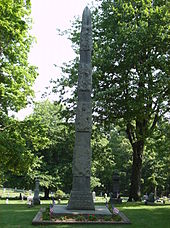Ashtabula railway accident
The Ashtabula railway accident occurred on December 29, 1876 near the city of Ashtabula in the US state of Ohio . After a bridge collapsed, a passenger train with more than 150 people on board fell 20 meters deep and went up in flames. 85 people died and 63 were injured. This was the worst train wreck in the United States until the Nashville rail accident on July 9, 1918.
Realities
Train No. 5 of the Lake Shore and Michigan Southern Railway , the Pacific Express , left the city of Erie , Pennsylvania on December 29, 1876 shortly after 6 p.m. with a delay of over two hours due to heavy snowfall the previous day. The train , drawn by two locomotives, consisted of eleven cars : two "express cars", two baggage cars , three passenger carriages , a social car and three sleeping cars . According to the subsequent investigation, 156 people are said to have been on board.
The scene of the accident was a bridge over the Ashtabula River with a span of about 50 meters, only about 300 meters in front of the Ashtabula train station . It was constructed by the engineer Charles Collins and the architect and designer Amasa B. Stone and was completed in the fall of 1865. The bridge was the first wrought iron truss bridge of this type. Collins did not agree with the construction of the bridge because he found it "too experimental".
the accident
The train was initially traveling at around ten miles per hour (16 km / h) in front of the accident site. Shortly before the scene of the accident, the train increased its speed to arrive against the heavy snow on the tracks and the strong headwind on the bridge over the Ashtabula River. At 7:28 p.m., while the train was crossing the bridge, the bridge collapsed and dropped the train 20 meters into the abyss. The front locomotive , named Socrates , had managed to cross the bridge, but the second locomotive, named Columbia , crashed along with the rest of the vehicles . The wreckage of the train immediately went up in flames, as the superstructures of the wagons - in keeping with the times - were mostly made of wood. The debris was immediately set on fire by the stoves and lamps that were fueled with kerosene .
The heat of the inferno melted the ice cover of the Ashtabula River, so that the burning debris partially sank and trapped passengers drowned. 92 people lost their lives as a result of the accident, including the American composer Philip Paul Bliss and his wife Lucy. 64 people were injured, some seriously. At least 48 victims were so badly mutilated or burned that they could no longer be identified. It was believed that most died from the fire, not the fall.
The rescue attempts were rather helpless, as the local fire brigade was not prepared for such a disaster. There was no organized rescue operation. Fire, smoke, darkness, the rough terrain and also the large amount of snow made the rescue efforts more difficult. Many residents and even survivors helped the fire fighters. About two dozen of the unidentified dead were buried in Chestnut Grove Cemetery in Ashtabula on January 19, 1877 after a funeral service. On May 30, 1895, a memorial was erected over her grave, financed in part by Ohio's governor and later US President William McKinley and former first lady Lucretia Garfield .
In the United States , the disaster is known as the Ashtabula River Railroad Disaster , Ashtabula Bridge Disaster or Ashtabula Horror .
examination
The official investigation by a jury of the responsible coroner began the day after the accident, on December 30, 1876. Dozens of witnesses were heard during the 68 day investigation. Charles Collins testified that he inspected the bridge eleven days before the accident. He did not notice anything. In the end, eight conclusions were made about the cause of the accident. This included the fact that the bridge had design and construction defects, a qualified inspection of the structure had not taken place and the wooden wagons were heated with an open fire. The investigation found that the disaster was largely the responsibility of the railway company . The local rescue workers, who reacted to the event with panic and chaos, instead of specifically saving lives, were blamed.
consequences
The railroad company paid $ 500,000 in compensation but refused to accept responsibility.
Charles Collins was found with a gunshot wound to the head a month after the accident. It was originally believed that he took his own life out of guilt. However, the police investigation revealed that Collins had not inflicted the wound on himself. However, his death was never investigated, and an alleged murderer was never investigated. Collins' mausoleum is just a few meters from the mass grave for the dead of the train wreck. Amasa Stone shot himself on May 11, 1883.
See also
Web links
- Findings of the coroner and his jury on the cause and cause of the accident
- More detailed information and photos of the accident
- The Ashtabula Train Disaster in the Ohio Online Encyclopedia
- Course of the accident, consequences, investigation, pictures
Coordinates: 41 ° 52 ′ 38 " N , 80 ° 47 ′ 49" W.




